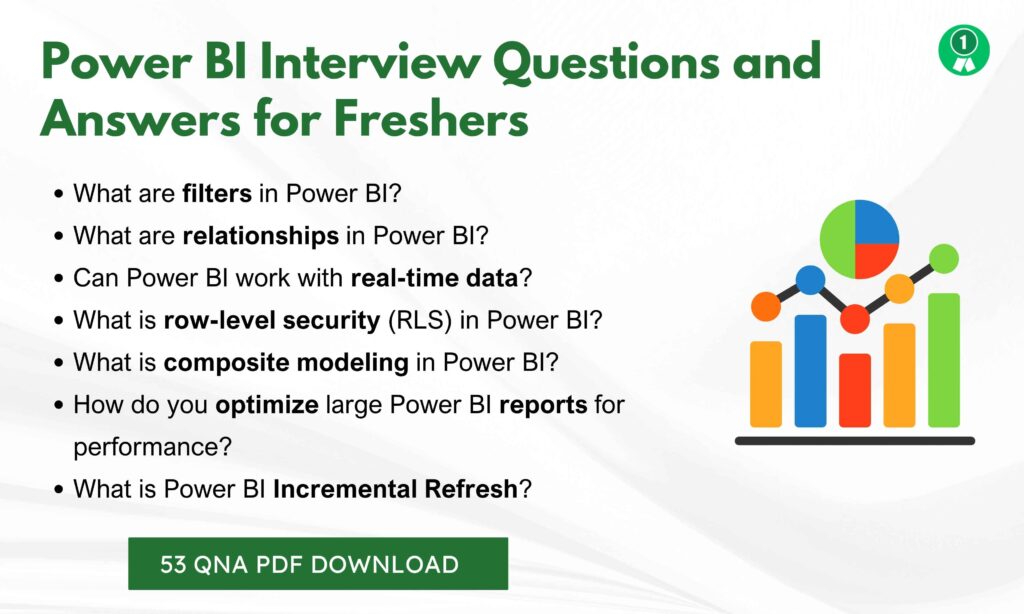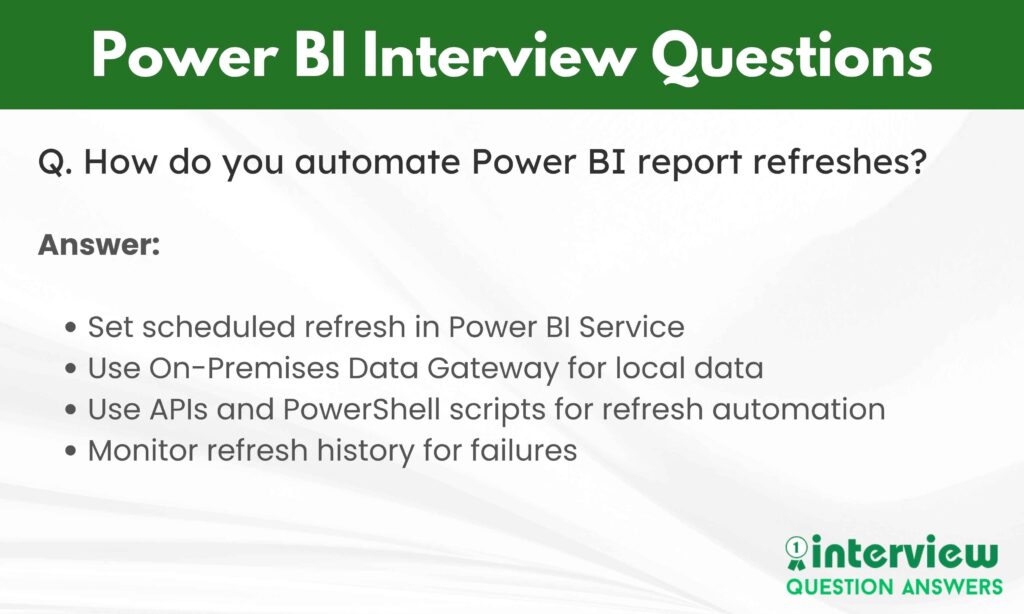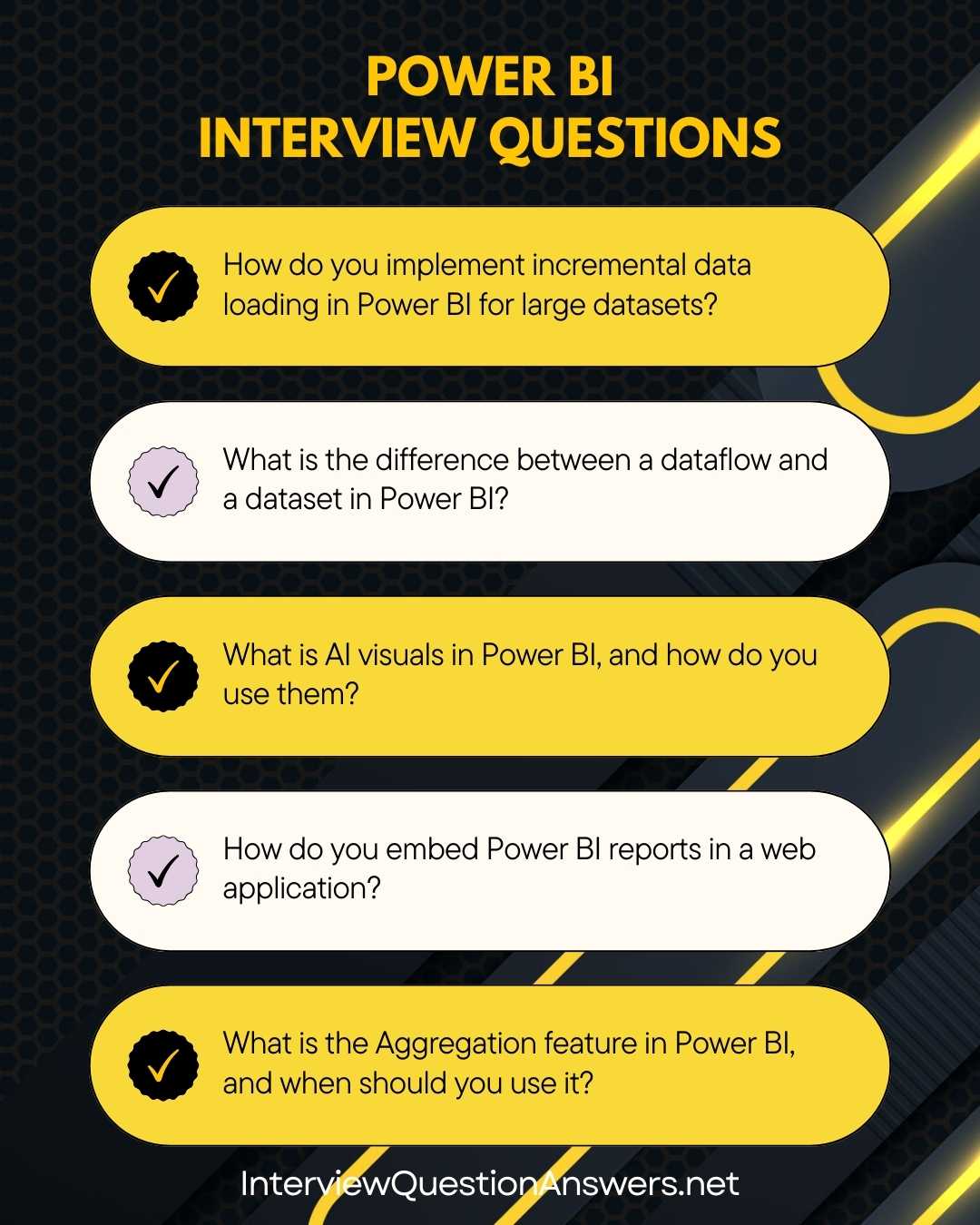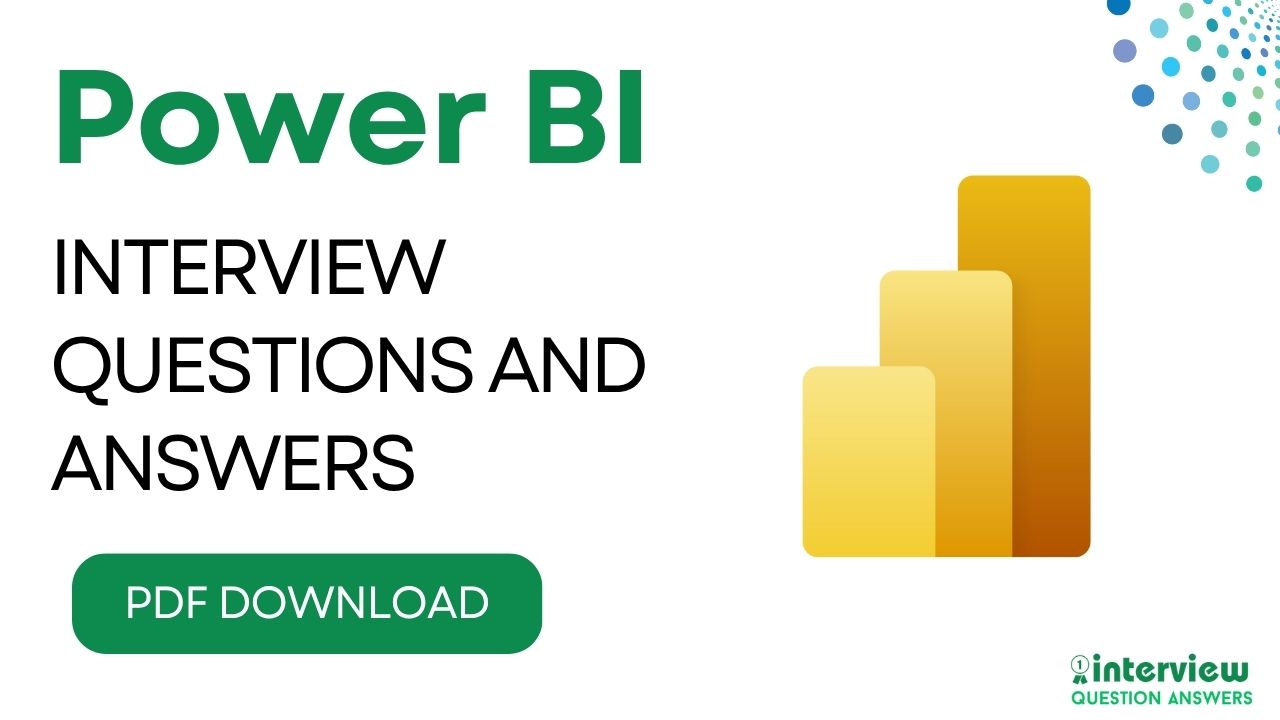Power BI is a popular tool used by companies to visualize and analyze their data. Professionals working with Power BI help businesses create interactive dashboards, build reports, and make smart decisions using data.
Here, we have shared most asked Power BI interview questions and answers. From beginner-level to advanced, scenario-based questions, this guide will help you prepare for real job interviews confidently. Topics include DAX, Power Query, data modeling, Row-Level Security, APIs, and much more.
This guide is designed for freshers as well as experienced professionals who want to refresh their knowledge and practice real world interview questions.
Table of Contents
Basic Power BI Interview Questions and Answers for Freshers
Que 1. What is Power BI used for?
Answer:
Power BI is a business analytics tool developed by Microsoft. It is used to connect to various data sources, visualize data through interactive dashboards and reports, and help organizations make data-driven decisions.
Que 2. What are the main components of Power BI?
Answer:
| Component | Description |
|---|---|
| Power BI Desktop | Used to create reports and build data models |
| Power BI Service | Online SaaS platform for sharing and collaborating on reports |
| Power BI Mobile | Mobile apps to view and interact with reports on the go |
| Power BI Gateway | Connects on-premises data sources to Power BI services |
| Power BI Report Server | On-premises solution to publish, manage, and view Power BI reports |
Que 3. What is Power Query?
Answer:
Power Query is a data transformation and preparation engine in Power BI. It allows users to clean, transform, and merge data from various sources before using it in reports.
Que 4. What is DAX in Power BI?
Answer:
DAX (Data Analysis Expressions) is a formula language used in Power BI to create custom calculations, measures, and calculated columns.
Que 5. What types of data sources can Power BI connect to?
Answer:
Power BI can connect to:
- Excel
- SQL Server
- SharePoint
- Azure
- Oracle
- Google Analytics
- Web APIs
- CSV files and many more
Que 6. What is a dashboard in Power BI?
Answer:
A dashboard in Power BI is a single-page visualization that shows key metrics and KPIs. It can display visuals from multiple reports, providing a consolidated view.
Que 7. Difference between Power BI Dashboard and Report?
Answer:
| Dashboard | Report |
|---|---|
| Single page | Multi-page |
| Can show visuals from different reports | Shows visuals from a single dataset |
| Read-only | Interactive with drill-through |
Que 8. What is a dataset in Power BI?
Answer:
A dataset is a collection of data that Power BI uses to create reports and dashboards. It can be imported from various sources or refreshed in real-time.
Que 9. What is Power BI Desktop used for?
Answer:
Power BI Desktop is a free application that allows users to:
- Connect to data
- Create data models
- Build reports and dashboards
- Publish reports to the Power BI service
Que 10. How do you publish a report in Power BI?
Answer:
After creating a report in Power BI Desktop, you can publish it directly to the Power BI Service using the “Publish” button, making it accessible online.
Que 11. What are filters in Power BI?
Answer:
Filters in Power BI help limit data in reports. Types include:
- Report-level filters
- Page-level filters
- Visual-level filters
- Slicers
Que 12. What is a slicer in Power BI?
Answer:
A slicer is a visual filter in Power BI. It allows users to select data interactively on reports, helping them view specific data points easily.
Que 13. What are relationships in Power BI?
Answer:
Relationships define how data tables are connected based on common columns (keys). Proper relationships enable accurate data modeling and aggregation.
Que 14. What are measures in Power BI?
Answer:
Measures are calculations created using DAX formulas to perform dynamic aggregations on data, such as sums, averages, or counts.
Que 15. What is drill-through in Power BI?
Answer:
Drill-through allows users to right-click on a data point and navigate to another page to see detailed data related to that specific point.
Que 16. Can Power BI work with real-time data?
Answer:
Yes, Power BI supports real-time data streaming using APIs, Azure Stream Analytics, and Power BI datasets.
Que 17. What are bookmarks in Power BI?
Answer:
Bookmarks capture the current state of a report page, including filters and visuals, allowing users to create guided navigation or storytelling in reports.
Que 18. What is the use of Power BI Service?
Answer:
Power BI Service is an online platform where reports and dashboards can be published, shared, and collaborated on within an organization.
Que 19. What is Power BI Gateway?
Answer:
Power BI Gateway is used to securely connect on-premises data sources to Power BI Service, enabling scheduled refreshes and live connections.
Que 20. How can you share Power BI reports with others?
Answer:
Reports can be shared via:
- Power BI Service dashboards
- Sharing links
- Publishing to Power BI apps
- Embedding in websites
- Exporting as PDF or PowerPoint

Also Check: Data Analyst Interview Questions and Answers
Que 21. What is Power Pivot in Power BI?
Answer:
Power Pivot is a data modeling tool in Power BI that enables advanced data analysis using in-memory technology. It allows users to create data models, establish relationships, and write basic DAX calculations within Power BI Desktop.
Que 22. How do you create a calculated table in Power BI?
Answer:
A calculated table is created using DAX in Power BI Desktop. Go to Modeling > New Table, enter a DAX expression to define the table, such as filtering or summarizing data from existing tables.
Que 23. What is the purpose of the Home tab in Power BI Desktop?
Answer:
The Home tab provides quick access to common tasks like connecting to data sources, refreshing data, creating visuals, and publishing reports to the Power BI Service.
Que 24. How do you apply a page-level filter in Power BI?
Answer:
In Power BI Desktop, go to the Filters pane, drag a field to the Page Filters section, and set conditions (e.g., select specific values or ranges) to filter all visuals on a report page.
Que 25. What is the difference between a visual and a report in Power BI?
Answer:
A visual is a single chart or graph (e.g., bar chart, table) displaying data, while a report is a collection of multiple visuals across one or more pages, designed to provide comprehensive insights.
Que 26. How do you change the data type of a column in Power BI?
Answer:
In Power BI Desktop, go to Power Query Editor, select the column, and choose the desired data type (e.g., Text, Number, Date) from the Data Type dropdown in the Transform tab.
Que 27. What is the role of the View tab in Power BI Desktop?
Answer:
The View tab allows users to toggle between report views (Report, Data, Model), enable themes, and adjust settings like showing the relationship view or data preview.
Que 28. How do you create a clustered bar chart in Power BI?
Answer:
In Power BI Desktop, select the Clustered Bar Chart visual from the Visualizations pane, drag a categorical field to the Axis and a numerical field to the Values section.
Que 29. What is the purpose of the Fields pane in Power BI?
Answer:
The Fields pane lists all tables and fields in the data model, allowing users to drag fields into visuals or filters to create reports and analyze data.
Que 30. How do you merge two tables in Power BI?
Answer:
In Power Query Editor, select Home > Merge Queries, choose the tables to merge, specify the join key (e.g., matching column), and select the join type (e.g., Inner, Left Outer).
Que 31. What is a card visual in Power BI?
Answer:
A card visual displays a single value or metric, such as total sales or average score, prominently in a report for quick reference.
Que 32. How do you add a title to a visual in Power BI?
Answer:
Select the visual in Power BI Desktop, go to the Format Visual pane, expand the Title section, and enter the desired title text with optional formatting like font or alignment.
Que 33. What is the purpose of the Bookmarks pane in Power BI?
Answer:
The Bookmarks pane saves specific report states (e.g., filters, slicers) to create interactive presentations or toggle between views, accessible via the View tab.
Que 34. How do you create a date hierarchy in Power BI?
Answer:
Power BI automatically creates a date hierarchy (Year, Quarter, Month, Day) when a date field is added to the data model. Ensure the field is set to Date type in Power Query Editor.
Que 35. What is the difference between a table and a matrix visual in Power BI?
Answer:
A table visual displays data in rows and columns without aggregation, while a matrix visual supports row and column groupings with aggregated values, similar to a pivot table.
Que 36. How do you apply conditional formatting in Power BI?
Answer:
Select a visual, click the field in the Values section, go to Data Bars, Background Color, or Font Color in the Format Visual pane, and define rules based on values.
Que 37. How do you group data in Power BI?
Answer:
In Power Query Editor, select a column, go to Home > Group By, choose the grouping field, and define aggregations (e.g., sum, count) for other columns.
Que 38. What is the purpose of the Report view in Power BI Desktop?
Answer:
The Report view is where users design interactive reports by adding visuals, configuring filters, and arranging layouts for data analysis and presentation.
Que 39. How do you import an Excel file into Power BI?
Answer:
In Power BI Desktop, click Home > Get Data > Excel, select the file, choose the desired worksheets or tables, and load or transform the data in Power Query Editor.
Que 40. What is the role of the Data view in Power BI Desktop?
Answer:
The Data view displays the raw data in tables from the data model, allowing users to inspect records, verify transformations, and check data quality.
Advanced Power BI Interview Questions and Answers for Experienced
Que 41. What is row-level security (RLS) in Power BI?
Answer:
Row-level security (RLS) restricts access to data for specific users by defining roles and filters. It ensures that users can only see data they are authorized to view within reports.
Que 42. How can you implement dynamic RLS in Power BI?
Answer:
Dynamic RLS uses user-specific data stored in tables. You can define roles using DAX expressions like USERNAME() and apply filters based on matching usernames or email IDs.
Que 43. Explain calculated columns vs measures in Power BI.
Answer:
- Calculated Columns: Created during data load; stored in the model; static
- Measures: Calculated at query time; dynamic based on slicers and filters; better for performance
Que 44. What is composite modeling in Power BI?
Answer:
Composite modeling allows combining DirectQuery and Import data sources in a single model, offering flexibility to use both real-time and static data together.
Que 45. What is a star schema, and why is it important in Power BI modeling?
Answer:
A star schema uses fact tables connected to dimension tables via relationships. It simplifies data models, improves query performance, and ensures efficient reporting in Power BI.
Que 46. How do you optimize large Power BI reports for performance?
Answer:
- Use star schema
- Reduce columns and rows
- Prefer measures over calculated columns
- Use aggregations
- Disable auto date/time
- Avoid complex visuals
- Use incremental data refresh
Que 47. What is the difference between DirectQuery and Import mode?
Answer:
- Import Mode: Data is loaded into Power BI, faster performance
- DirectQuery Mode: Queries data in real-time directly from the source, useful for live datasets but slower
Que 48. What is Power BI Incremental Refresh?
Answer:
Incremental refresh updates only new or changed data during scheduled refresh, instead of reloading the entire dataset, enhancing performance for large datasets.
Que 49. How can you troubleshoot slow Power BI reports?
Answer:
- Analyze using Performance Analyzer
- Optimize DAX expressions
- Simplify visuals
- Minimize data volume
- Use aggregations
- Avoid too many slicers and filters
Que 50. Explain the purpose of Tabular Editor in Power BI.
Answer:
Tabular Editor is an external tool that allows advanced management of Power BI models, helping in creating measures, calculated columns, and managing roles efficiently without using Power BI Desktop UI.
Que 51. How do you manage deployments using Power BI pipelines?
Answer:
Power BI deployment pipelines help manage report versions across development, test, and production environments, ensuring smooth content promotion and version control.
Que 52. What are aggregations in Power BI and why use them?
Answer:
Aggregations store summarized data to improve performance. By querying pre-aggregated data, reports load faster, especially when working with large datasets.
Que 53. How can you connect Power BI to APIs for data import?
Answer:
- Use Power Query’s Web connector
- Handle authentication (basic, API key, OAuth)
- Parse JSON/XML data into tables
- Build custom functions if required for pagination
Que 54. What are incremental loading policies in Power BI?
Answer:
They define rules on how much historical data is loaded initially and how future updates handle new or changed data. It is set in Power BI Desktop for published datasets.
Que 55. Explain the ALM Toolkit usage in Power BI.
Answer:
The ALM Toolkit helps compare, manage, and deploy metadata between different Power BI datasets or Analysis Services models, streamlining version control and deployment processes.
Que 56. What is a Composite Model and how is it different from traditional models?
Answer:
A Composite Model allows mixing DirectQuery and Import data sources. Unlike traditional models (Import or DirectQuery only), it lets you use both simultaneously, offering flexibility and optimized performance.
Que 57. How do you handle many-to-many relationships in Power BI?
Answer:
Using a bridging (relationship) table and setting relationships properly allows you to manage many-to-many scenarios. Use “Both” cross-filter direction carefully to avoid incorrect aggregations.
Que 58. What is Power BI Dataflow?
Answer:
Power BI Dataflows allow creating ETL processes in the Power BI service. They help preprocess data centrally using Power Query online before using it in Power BI reports.
Que 59. How do you automate Power BI report refreshes?
Answer:
- Set scheduled refresh in Power BI Service
- Use On-Premises Data Gateway for local data
- Use APIs and PowerShell scripts for refresh automation
- Monitor refresh history for failures
Que 60. How do you share large datasets across reports efficiently?
Answer:
Use Power BI Shared Datasets feature. Create a centralized dataset and connect multiple reports to it, reducing redundancy and improving manageability across teams.

Also Check: Data Engineer Interview Questions and Answers
Que 61. How do you implement incremental data loading in Power BI for large datasets?
Answer: Incremental loading refreshes only new or changed data, reducing load times. Enable it in Power BI Service for Premium workspaces by defining a date-based partition in the data model (e.g., using a Date column). Configure parameters in Power Query for start/end dates, then publish and set up refresh policies in the dataset settings.
Que 62. What is the difference between a dataflow and a dataset in Power BI?
Answer: A dataflow is a reusable data transformation pipeline in Power BI Service, storing prepared data in Azure Data Lake. A dataset is the final model for reporting, combining dataflows or direct sources. Dataflows promote reuse across datasets, while datasets are optimized for analysis.
Que 63. How do you create and use custom visuals in Power BI?
Answer: Custom visuals are built using the Power BI Visuals SDK with TypeScript and D3.js. Install the SDK via npm, create a project with pbiviz new, define capabilities.json for data roles, and implement render logic. Package with pbiviz package and import into Power BI Desktop for use.
Que 64. What is AI visuals in Power BI, and how do you use them?
Answer: AI visuals leverage machine learning for insights, like key influencers or decomposition tree. In Power BI Desktop, select the AI visual from the Visualizations pane, add fields (e.g., measures for analysis), and configure options to identify trends or anomalies automatically.
Que 65. How do you embed Power BI reports in a web application?
Answer: Use Power BI Embedded with Azure or Embedded Analytics. Generate an embed token via the Power BI REST API, then use the Power BI JavaScript SDK to render reports in an iframe, handling authentication and RLS for secure embedding.
Que 66. What is the purpose of the Power BI Admin Portal?
Answer: The Admin Portal manages tenant settings, usage monitoring, capacities, and gateways. Admins configure data gateway installations, monitor refresh failures, set up audit logs, and enforce policies like export restrictions for organizational compliance.
Que 67. How do you handle bidirectional relationships in Power BI data models?
Answer: Bidirectional relationships allow filtering in both directions but can cause ambiguity loops. Enable them in the Model view, but use sparingly; prefer single-direction with CROSSFILTER in DAX for complex scenarios to avoid performance issues.
Que 68. What is the Aggregation feature in Power BI, and when should you use it?
Answer: Aggregations precompute summarized data for faster queries on large datasets. Define aggregation tables in the model, mapping to detail tables. Use for billion-row datasets to reduce query times from seconds to milliseconds in DirectQuery mode.
Que 69. How do you integrate Power BI with Azure services like Azure Synapse Analytics?
Answer: Connect Power BI to Azure Synapse via DirectQuery or Import mode. Use Azure AD for authentication, leverage Synapse’s serverless SQL pools for querying large data lakes, and enable auto-refresh for real-time analytics.
Que 70. What is the Decomposition Tree visual, and how does it work?
Answer: The Decomposition Tree is an AI visual that breaks down measures by dimensions hierarchically. Add a measure (e.g., Sales) and dimensions (e.g., Region, Product), allowing users to drill down interactively to analyze contributions.
Que 71. How do you manage workspaces and apps in Power BI Service?
Answer: Workspaces organize datasets, reports, and dashboards; create them in Power BI Service. Apps bundle content for distribution to users without workspace access, published from workspaces with permissions set for viewers.
Que 72. What is the Smart Narrative visual in Power BI?
Answer: Smart Narrative uses AI to generate textual summaries of visuals or datasets, highlighting key insights like trends or anomalies. Add it from the Visualizations pane and configure to reference specific visuals for automated explanations.
Que 73. How do you use Power BI’s What-If parameters for scenario analysis?
Answer: What-If parameters create slicers for hypothetical values. In Modeling tab, select New Parameter, define range (e.g., discount rate 0-20%), and use the generated measure in DAX calculations for dynamic scenarios.
Que 74. What is the impact of using too many visuals on a Power BI report page?
Answer: Too many visuals increase rendering time, leading to slow performance and higher resource usage. Limit to 10-15 per page, use drill-through for details, and optimize DAX to minimize query loads.
Que 75. How do you implement row-level security (RLS) with dynamic user-based filtering in Power BI?
Answer: Define RLS in the Modeling tab by creating roles with DAX filters (e.g., [UserEmail] = USERPRINCIPALNAME()). Assign users/groups to roles in Power BI Service, ensuring data is filtered per user upon viewing.
Que 76. What is the Key Influencers visual, and how does it work?
Answer: Key Influencers uses AI to identify factors influencing a metric (e.g., what drives high sales). Add the metric and explanatory fields; it analyzes data to show top influencers and segments.
Que 77. How do you connect Power BI to on-premises data sources securely?
Answer: Use the On-Premises Data Gateway in Standard mode for secure connections. Install the gateway, configure data sources in Power BI Service, and schedule refreshes with enterprise credentials.
Que 78. What is the purpose of the Q&A visual in Power BI?
Answer: The Q&A visual allows natural language queries for data exploration, generating visuals based on questions (e.g., “total sales by region”). It uses AI to interpret queries and suggest synonyms for better accuracy.
Que 79. How do you handle data refresh failures in Power BI Service?
Answer: Check refresh history in dataset settings for error details (e.g., credential issues). Update gateways, verify connections, and set up email notifications for failures to ensure timely resolution.
Que 80. What is the Decomposition Tree visual’s advantage over standard hierarchies?
Answer: It allows dynamic, AI-driven exploration across multiple dimensions without predefined hierarchies, enabling users to choose breakdown paths interactively for deeper insights.

Scenario-based Power BI Interview Questions and Answers
Que 81. A report is loading slowly. How will you troubleshoot and fix the issue?
Answer:
- Use the Performance Analyzer to identify slow visuals.
- Simplify DAX expressions and avoid unnecessary calculated columns.
- Reduce dataset size by removing unused columns.
- Limit complex visuals like maps or excessive slicers.
- Switch from DirectQuery to Import mode if appropriate.
Que 82. How will you handle a request to limit sensitive data access for certain users in a report?
Answer:
- Implement Row-Level Security (RLS).
- Create user roles and apply DAX filters to restrict data.
- Test roles using the “View As Role” feature before deploying.
Que 83. A stakeholder wants to view live sales data in a dashboard. What approach will you use?
Answer:
- Use DirectQuery mode to connect directly to the sales database.
- Alternatively, use streaming datasets or Azure Stream Analytics for real-time reporting.
Que 84. How will you handle reports showing incorrect aggregations due to many-to-many relationships?
Answer:
- Create a bridging table to properly relate the datasets.
- Define the correct cross-filter direction carefully.
- Validate aggregation results with stakeholders after applying changes.
Que 85. Your Power BI dataset is too large to refresh daily. How will you manage it?
Answer:
- Use Incremental Refresh to load only new and changed records.
- Archive historical data separately if necessary.
- Optimize queries in Power Query to reduce data load time.
Que 86. You’re asked to integrate Power BI with a custom web application. How will you proceed?
Answer:
- Use Power BI REST API or JavaScript embedding techniques.
- Ensure authentication using Azure Active Directory or Embed Token approach.
- Control access permissions using workspace roles and RLS if needed.
Que 87. A report consumer is not seeing updated data after a scheduled refresh. What steps will you take?
Answer:
- Check refresh history in Power BI Service for errors.
- Verify Data Gateway status if using on-premises sources.
- Ensure the schedule is active and dataset credentials are valid.
- Manually trigger a refresh to test resolution.
Que 88. How would you optimize a DAX measure performing poorly in large datasets?
Answer:
- Replace complex calculated columns with efficient measures.
- Use aggregation functions carefully (e.g., SUMX instead of SUM when appropriate).
- Minimize row context using variables to reduce repeated calculations.
- Avoid excessive use of RELATED and FILTER functions.
Que 89. What steps would you take to migrate Power BI reports from Dev to Production?
Answer:
- Use Deployment Pipelines in Power BI Service.
- Validate datasets and reports in the Test environment.
- Promote to Production after testing.
- Use ALM Toolkit for metadata comparison and deployment.
Que 90. A client needs offline access to reports. How will you support this?
Answer:
- Export reports as PDF or PowerPoint files for offline viewing.
- Use Power BI Report Server for deploying on-premises reports where internet access isn’t reliable.
Que 91. How will you handle multiple country managers requiring region-specific dashboards?
Answer:
- Set up Row-Level Security based on country/region fields.
- Use dynamic filtering in reports using the
USERNAME()function in DAX. - Deploy a single report that shows personalized data based on user login.
Que 92. A client wants to visualize data from both SQL Server and Excel in one report. What approach will you follow?
Answer:
- Use Composite Model in Power BI Desktop to combine Import (Excel) and DirectQuery (SQL Server).
- Build relationships between tables from both sources.
- Ensure data model performance optimization to handle mixed data sources.
Que 93. What steps will you follow when a report page needs to tell a clear business story?
Answer:
- Use bookmarks and buttons for guided navigation.
- Design the report layout logically with clear KPIs upfront.
- Apply consistent color themes and limit unnecessary visuals.
- Add tooltips and clear labels for user understanding.
Que 94. A user reports that their Power BI report shows outdated data even after refreshing the dataset. How would you troubleshoot this issue?
Answer:
First, verify the refresh schedule in the Power BI Service under dataset settings to ensure it’s set correctly and check the refresh history for failures (e.g., gateway issues or credential expiration). If using DirectQuery, test the underlying data source connection. For Import mode, confirm if incremental refresh is enabled and partitions are updating. Clear browser cache or try in incognito mode to rule out client-side caching. If the issue persists, examine dataflow dependencies or use Performance Analyzer in Power BI Desktop to trace query execution times.
Que 95. You need to create a report that combines data from multiple sources with varying refresh rates. How would you design the data model to handle this efficiently?
Answer:
Use composite models in Power BI, combining Import mode for static data (e.g., historical sales) and DirectQuery for real-time data (e.g., live inventory). Define relationships in the model view, ensuring a common key (e.g., date or ID). Enable aggregations for the imported data to speed up queries. Test with sample data to avoid performance hits, and monitor query logs in the Power BI Service to optimize.
Que 96. A dashboard visual is not updating when filters are applied from another page. What could be the cause, and how would you fix it?
Answer:
The issue might be due to cross-filtering being disabled or the visual using a measure that ignores filters. Check the interactions in the report by selecting the visual and editing interactions (via Format > Edit Interactions). If it’s a DAX measure, ensure it uses functions like ALL() appropriately. To fix, adjust the measure with CALCULATE() and FILTER(), or enable cross-filtering. Republish and test the dashboard.
Que 97. Your team wants to embed a Power BI report in a custom web app with user-specific data views. How would you approach this?
Answer:
Use Power BI Embedded with row-level security (RLS). Define roles in the Power BI Desktop model with DAX filters (e.g., [User] = USERPRINCIPALNAME()), assign users to roles in the service, and generate embed tokens via the Power BI REST API with the user’s identity. On the web app, use the Power BI JavaScript SDK to render the report, passing the token for secure, filtered views.
Que 98. A Power BI dataset refresh fails intermittently due to data source errors. How would you diagnose and resolve this?
Answer:
Check the refresh history in Power BI Service for error details (e.g., “Data source credentials are invalid”). Verify gateway status if on-premises, and test connections in Power BI Desktop. For intermittent issues, examine source logs (e.g., SQL Server error logs) for timeouts or network problems. Resolve by updating credentials, increasing timeouts in Power Query, or scheduling refreshes during low-load periods. Set up email alerts for failures.
Que 99. You need to visualize sales trends over time with dynamic date ranges. How would you implement this in Power BI?
Answer:
Create a date table with a relationship to the sales data, then use a slicer with relative date filtering (e.g., “Last 30 days”). Add a line chart visual with the date on the x-axis and sales measure on the y-axis. For dynamic ranges, use a What-If parameter for custom periods and DAX measures like TOTALYTD() or DATESINPERIOD() to calculate trends.
Que 100. Stakeholders require a report that combines on-premises SQL data with cloud-based Excel files. How would you build and maintain this dataset?
Answer:
Use Power BI Desktop to connect to SQL via DirectQuery (for real-time) and import Excel data. Merge in Power Query, handling any schema differences with transformations. Publish to Power BI Service, install an On-Premises Gateway for SQL refreshes, and schedule automatic updates. For maintenance, use dataflows to centralize transformations and monitor gateway health for seamless hybrid data handling.
Power BI Interview Questions PDF
We have also attched a PDF below that includes all the Power BI interview questions and answers shared in this guide. You can save it and prepare offline anytime.
FAQs: Power BI Interview Questions
What is the role of a Power BI professional?
A Power BI professional focuses on transforming raw data into meaningful insights using Power BI tools. Their responsibilities include creating dashboards, building reports, performing data analysis, and helping organizations make data-driven decisions through clear visualizations and reporting.
What challenges do candidates face during a Power BI interview?
In Power BI interviews, candidates often struggle with DAX (Data Analysis Expressions), understanding data modeling concepts, and explaining their approach to building reports. Practical scenario-based questions about handling large datasets and optimizing report performance are also common hurdles.
What are common job challenges for a Power BI Developer?
Power BI Developers face challenges like managing complex data relationships, ensuring data accuracy, optimizing slow reports, and integrating various data sources. Keeping up with frequent Power BI updates and best practices for data visualization is also part of the job.
How important is SQL knowledge for a Power BI professional?
SQL knowledge is quite important for Power BI professionals. It helps in writing queries, performing data transformations, and working efficiently with relational databases. Strong SQL skills enable better data preparation before building reports in Power BI.
What is the average salary of a Power BI professional in the USA?
In the USA, entry-level Power BI professionals typically earn between $70,000 and $90,000 per year. With more experience and advanced skills in data analysis and SQL, salaries can exceed $100,000 annually, especially in data-driven organizations.
Which top companies hire Power BI professionals?
Top companies hiring Power BI professionals include Microsoft, Deloitte, Accenture, IBM, Capgemini, TCS, Infosys, and many mid-size firms focusing on data analytics. Businesses across healthcare, finance, and retail sectors also require Power BI experts for their reporting needs.
Why is interview preparation important for Power BI roles?
Interview preparation is crucial for Power BI roles as it helps candidates sharpen their understanding of DAX, data modeling, and visualization techniques. Practicing hands-on scenarios, understanding Power BI architecture, and learning how to explain insights effectively can greatly improve interview performance.







